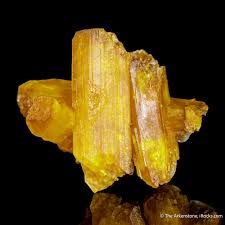
Legrandite: A Radiant Rarity in the World of Raw Crystals
A Glimpse into Golden Light
Legrandite is one of those minerals that seems to glow from within — a golden, sulphur-hued crystal so vivid it’s almost luminous. Rare and often misunderstood, this zinc arsenate mineral is a prized collector’s gem and a metaphysical beacon of light and clarity. In this post, we delve into the geological essence, energetic significance, and raw beauty of Legrandite, especially as it appears in mineral specimen jewellery.
Geological Profile of Legrandite
-
Chemical Composition: Zn₂(AsO₄)(OH)·H₂O (Zinc Arsenate Hydroxide Hydrate)
-
Crystal System: Monoclinic
-
Hardness: 4.5 on the Mohs scale
-
Colour: Bright to golden yellow, sometimes with orange undertones
-
Transparency: Transparent to translucent
-
Primary Localities: The most celebrated specimens hail from the Ojuela Mine in Mapimí, Durango, Mexico, known for producing Legrandite with spectacular radiance and crystal form. Smaller deposits have also been found in Namibia, Greece, and the US.
Legrandite typically forms in oxidised zones of arsenic-rich zinc deposits and often grows as slender, radiating sprays or fan-like clusters — a formation that adds both elegance and fragility to its natural state. This crystalline habit makes it particularly compelling when left in its raw, unpolished form for jewellery.

Energetic Significance & Healing Properties
Legrandite is considered a stone of mental clarity, illumination, and aligned action. Its yellow light resonates with the solar plexus chakra, supporting:
-
Confidence & self-expression
-
Mental acuity and decisiveness
-
Emotional warmth and upliftment
-
Spiritual inspiration, especially when seeking guidance in times of transformation
Practitioners of crystal healing often describe Legrandite as a “light bringer” — a stone that helps dispel mental fog and awakens one’s higher purpose with clarity and gentle encouragement.
Its solar quality is also said to bring resilience during dark emotional seasons, making it a companion for inner alchemy.
Legrandite’s Natural Beauty & Collectibility
Legrandite is not only rare but also highly sensitive to touch, heat, and moisture, making well-preserved raw specimens exceptionally valuable. Its fine crystals are often small, yet they display a dramatic presence due to their radiant colour and precise geometry.
Collectors treasure Legrandite for its:
-
Uncommon vibrancy within the yellow mineral spectrum
-
Fine fan or blade-like crystal clusters that resemble miniature golden wings
-
Difficulty in sourcing undamaged raw specimens, which enhances its exclusivity
Unlike more common crystals like citrine or yellow fluorite, Legrandite is seldom available in quantity — making it a perfect choice for curated raw crystal jewellery collections that honour both form and frequency.
Legrandite in Comparison with Other Crystals
Legrandite’s brilliant golden hue may invite comparisons with more common yellow stones like Citrine, Yellow Apatite, or Heliodor, but there are notable differences:
-
Citrine is more durable and often heat-treated, while Legrandite is fragile and entirely natural in colour.
-
Yellow Apatite can have a similar energetic brightness, yet lacks the lustrous, fan-like crystal habit of Legrandite.
-
Heliodor (Golden Beryl) has greater brilliance in gem form, but Legrandite holds more interest for mineralogical collectors due to its rarity and unrefined aesthetic.
Legrandite stands apart in the mineral world for its combination of scarcity, aesthetic delicacy, and high vibrational energy — making it especially aligned with those drawn to crystals for spiritual clarity or personal transformation.
Legrandite in Jewellery: A Dance of Light and Fragility
Due to its softness (4.5 Mohs) and sensitivity to heat, Legrandite is seldom faceted or used in traditional gemstone settings. However, in raw crystal jewellery — particularly mineral specimen necklaces and crystal specimen rings — it offers a vivid, sculptural elegance that is both earthy and celestial.
When incorporated with care into jewellery, Legrandite is:
-
Best displayed in protected settings, such as closed-back or resin-encased designs
-
Often highlighted alongside other crystals in multi-stone talismans
-
Celebrated for its visual drama, often left untouched to preserve its wild, natural splendour
It suits those who appreciate jewellery that feels more like a living artefact than a polished ornament — ideal for spiritual practitioners, intuitive creatives, or seekers of light.

Cultural and Historical Notes
Legrandite does not carry the same deep mythological lore as some ancient crystals, primarily due to its modern discovery and limited accessibility. However, in contemporary metaphysical circles, it is sometimes referred to as the “Ray of Realisation” — a crystal for visionaries and truth-seekers navigating uncertain transitions.
Its spiritual use is intuitive rather than historical, with many reporting that Legrandite enhances personal revelation, making it popular among energy workers, writers, and healers who rely on clarity in their creative or intuitive flow.
A Subtle Nod to the Brand
For those who seek crystals not only for their aesthetic rarity but also their energetic resonance, Legrandite represents a perfect synergy of both. Within a curated collection of raw and rare stones, it shines as a quiet beacon of light — a piece of the sun held in crystalline form.
When offered in mineral specimen jewellery, its presence becomes more than ornamental; it becomes a guide — worn close, illuminating your personal path.